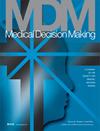为加拿大的 EQ-5D-5L 创建乘法推算值集:正确描述参数不确定性需要州级误判项
IF 3.1
3区 医学
Q2 HEALTH CARE SCIENCES & SERVICES
引用次数: 0
摘要
背景EQ-5D-5L值集中参数的不确定性往往超过仪器的最小重要差异,但这一点通常被忽视。多重估算(MI)考虑了值集中参数的不确定性;然而,还没有任何估值研究采用过这种方法。我们的目标是为 EQ-5D-5L 创建一个加拿大 MI 值集,从而使用户能够考虑到值集中参数的不确定性。方法利用加拿大 EQ-5D-5L 估值研究(N = 1,073),我们首先对原始模型进行了重拟,然后对具有国家级错误规范的模型进行了重拟。根据样本外预测的 95% 可信区间 (CrI) 覆盖率对模型进行比较。使用最佳拟合模型,我们从后验分布中抽取 100 次,创建 100 个估算值集。我们使用 MI 值集和原始值集对以下两个数据集进行评分:1)1 208 个加拿大普通公众样本;2)401 个乳腺癌女性患者样本,考察了在考虑值集中参数的不确定性后,估计平均健康效用的标准误差增加了多少。我们观察到,在使用 MI 值集时,加拿大普通公众(MI:0.0091;原始值:0.0035)和乳腺癌患者(MI:0.0169;原始值:0.0066)的平均效用估计值的标准误差均有所扩大。我们的研究表明,忽略价值集中参数的不确定性会导致错误的窄SE.Highlights健康状态效用工具价值集的估计受参数不确定性的影响;这种参数不确定性可能超过工具的最小重要差异,但目前的方法并不能完全捕捉到这种不确定性。本研究首次为多属性效用工具(EQ-5D-5L)创建了多重估算值集,以充分捕捉这种参数不确定性。我们将该多重估算值集应用于两个数据集:1)加拿大普通公众;2)患有浸润性乳腺癌的妇女。使用多重估算值集对 EQ-5D-5L 进行评分会导致更宽的标准误差估计值,这表明目前在值集中忽略参数不确定性的做法会导致错误的低标准误差。EQ-5D-5L的方法论专家和开发人员以及EQ-5D-5L的用户(如卫生经济学家、研究人员和政策制定者)都会对我们的工作感兴趣。本文章由计算机程序翻译,如有差异,请以英文原文为准。
Creating a Multiply Imputed Value Set for the EQ-5D-5L in Canada: State-Level Misspecification Terms Are Needed to Characterize Parameter Uncertainty Correctly
BackgroundParameter uncertainty in EQ-5D-5L value sets often exceeds the instrument’s minimum important difference, yet this is routinely ignored. Multiple imputation (MI) accounts for parameter uncertainty in the value set; however, no valuation study has implemented this methodology. Our objective was to create a Canadian MI value set for the EQ-5D-5L, thus enabling users to account for parameter uncertainty in the value set.MethodsUsing the Canadian EQ-5D-5L valuation study ( N = 1,073), we first refit the original model followed by models with state-level misspecification. Models were compared based on the adequacy of 95% credible interval (CrI) coverage for out-of-sample predictions. Using the best-fitting model, we took 100 draws from the posterior distribution to create 100 imputed value sets. We examined how much the standard error of the estimated mean health utilities increased after accounting for parameter uncertainty in the value set by using the MI and original value sets to score 2 data sets: 1) a sample of 1,208 individuals from the Canadian general public and 2) a sample of 401 women with breast cancer.ResultsThe selected model with state-level misspecification outperformed the original model (95% CrI coverage: 94.2% v. 11.6%). We observed wider standard errors for the estimated mean utilities on using the MI value set for both the Canadian general public (MI: 0.0091; original: 0.0035) and patients with breast cancer (MI: 0.0169; original: 0.0066).Discussion and ConclusionsWe provide 1) the first MI value sets for the EQ-5D-5L and 2) code to construct MI value sets while accounting for state-level model misspecification. Our study suggests that ignoring parameter uncertainty in value sets leads to falsely narrow SEs.HighlightsValue sets for health state utility instruments are estimated subject to parameter uncertainty; this parameter uncertainty may exceed the minimum important difference of the instrument, yet it is not fully captured using current methods. This study creates the first multiply imputed value set for a multiattribute utility instrument, the EQ-5D-5L, to fully capture this parameter uncertainty. We apply the multiply imputed value set to 2 data sets from 1) the Canadian general public and 2) women with invasive breast cancer. Scoring the EQ-5D-5L using a multiply imputed value set led to wider standard error estimates, suggesting that the current practice of ignoring parameter uncertainty in the value set leads to falsely low standard errors. Our work will be of interest to methodologists and developers of the EQ-5D-5L and users of the EQ-5D-5L, such as health economists, researchers, and policy makers.
求助全文
通过发布文献求助,成功后即可免费获取论文全文。
去求助
来源期刊

Medical Decision Making
医学-卫生保健
CiteScore
6.50
自引率
5.60%
发文量
146
审稿时长
6-12 weeks
期刊介绍:
Medical Decision Making offers rigorous and systematic approaches to decision making that are designed to improve the health and clinical care of individuals and to assist with health care policy development. Using the fundamentals of decision analysis and theory, economic evaluation, and evidence based quality assessment, Medical Decision Making presents both theoretical and practical statistical and modeling techniques and methods from a variety of disciplines.
 求助内容:
求助内容: 应助结果提醒方式:
应助结果提醒方式:


